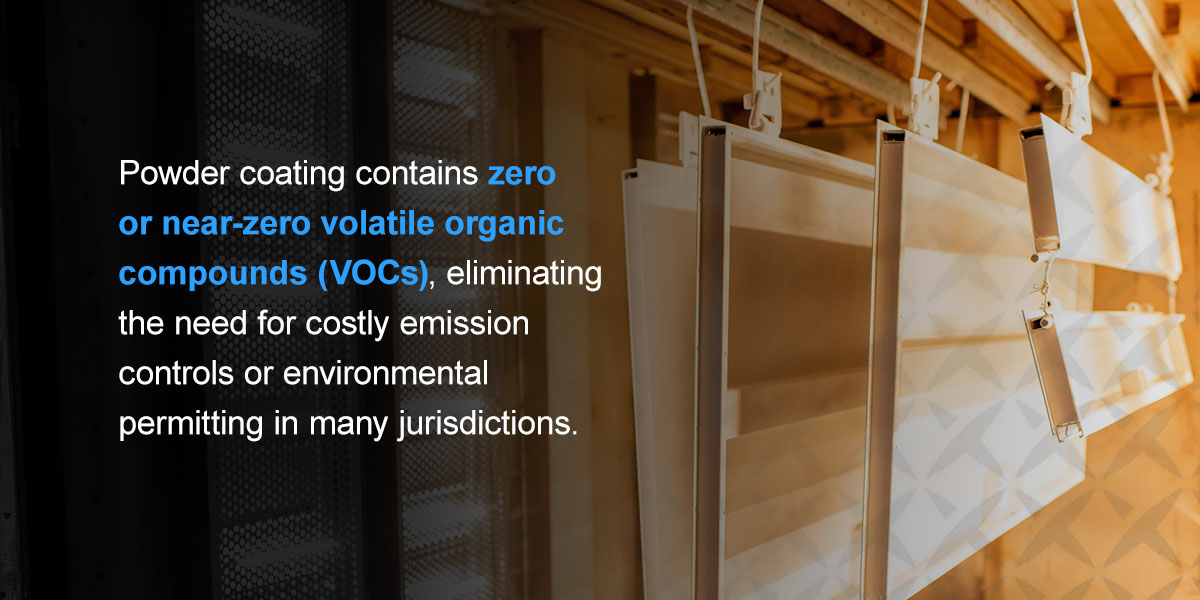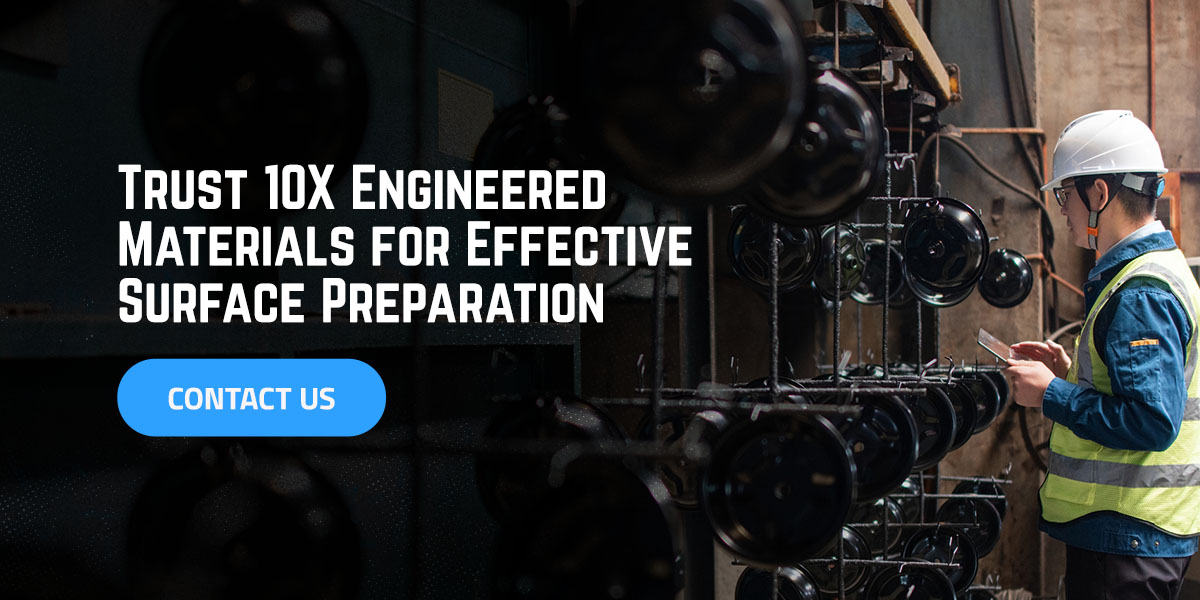Pros and Cons of Powder Coating
Powder coating has become a leading finishing solution across industries. Its appeal lies in its combination of durability, efficiency, and environmental performance. For sandblasting professionals and surface preparation teams, understanding the full capabilities, including the many advantages of powder coating and its limitations, is critical to delivering coatings that perform as expected in the field.
What Is Powder Coating?
Powder coating is a dry finishing process that uses finely ground pigment and resin particles to create a durable, protective, and aesthetically appealing finish on metal surfaces. Common in automotive, industrial, and architectural applications, powder coating offers a resilient, high-performance alternative to traditional liquid paint, with superior corrosion, chemical, and weather resistance. It is available in a wide variety of chemistries, including:
- Epoxy
- Polyester
- Polyurethane
- Acrylic
- Hybrid blends
The powder coating process starts with a clean, prepped surface, typically achieved through abrasive blasting. A technician uses a spray gun to apply the powder with a positive electrostatic charge to the powder particles. The grounded metal part, bearing a negative charge, attracts the charged powder, causing the particles to adhere evenly across the surface. After application, the coated part enters a curing oven. The heat melts the powder, allowing it to flow and cross-link into a smooth, hardened finish.
What Are the Pros of Powder Coating?
Powder coating offers several technical and operational advantages, making it the preferred finish in a wide range of industrial and consumer applications. Aside from well-known benefits like reliable color matching and uniform gloss levels from batch to batch, professionals choose powder coating for its:
Superior Durability
Powder-coated finishes resist abrasion, corrosion, impact, and chemical exposure better than most wet-applied coatings. Once cured, the thermoset or thermoplastic resin forms a dense, cross-linked molecular structure that shields the substrate from moisture, ultraviolet (UV) radiation, and mechanical wear. This durability is critical in outdoor environments, harsh industrial settings, and high-contact applications, such as vehicle chassis, railings, and equipment frames.
Excellent Adhesion
Powder coatings bond mechanically and chemically to the substrate. When applied to a properly blasted surface, the coating forms an interlocking grip with the substrate, minimizing the risk of delamination. This makes powder coating especially compatible with abrasive blasting as a prep step, where achieving consistent surface profiles and cleanliness directly translates to higher coating performance.
Uniform Finish
Because powder is applied as a dry, free-flowing material, it doesn’t drip, run, or sag like liquid paint. Electrostatic application ensures the powder wraps around edges and into recesses, forming a continuous film even on complex geometries. This uniformity minimizes the need for rework or sanding between coats, saving labor hours and improving finish quality.
High Transfer Efficiency
Typical transfer efficiency for electrostatically sprayed powder coating ranges from 50% to 85% on the first pass, with recovery systems allowing high reclaim of the unused powder. Unlike solvent-based paints, which suffer from overspray loss and evaporation, unused powder can be collected, filtered, and applied. This reduces material waste and lowers the total cost per part.
Minimal VOC Emissions

Powder coating contains zero or near-zero volatile organic compounds (VOCs), eliminating the need for costly emission controls or environmental permitting in many jurisdictions. This makes it easier to comply with environmental regulations, improves workplace safety, and reduces the overall environmental footprint.
Because powder coatings contain no solvents and generate minimal airborne contaminants during application, the working environment is generally safer and cleaner for applicators compared to traditional liquid paint systems.
Short Cure Times
Curing cycles for powder coating are generally shorter than for many liquid paints, especially high-performance two-part systems. Once the substrate reaches the specified metal temperature, the powder begins to flow and cross-link in minutes. This rapid curing allows for faster turnaround in production environments and often eliminates the need for extended drying racks or complex ventilation systems. These conditions reduce the total cost of ownership for powder coating, which increases revenue per part.
What Are the Cons of Powder Coating?
While powder coating is widely regarded for its durability and environmental benefits, it does have specific limitations. These challenges can affect material selection, equipment investment, part design, and application method. The disadvantages of powder coating include:
- High initial costs: Setting up a powder coating line requires significant capital investment. This includes spray booths with airflow and filtration, electrostatic spray guns, powder feed systems, and a curing oven large enough to accommodate the coated parts.
- Limited suitability: Powder coating only works on a conductive surface, which limits the materials it can be applied to. As it needs to be cured in an oven, powder coating can’t be applied to materials that may melt, unless you use specialized powders and techniques.
- Difficult field repairs: Powder coating typically requires full reprocessing for repair. Damaged areas often need to be stripped, reblasted, recoated, and recured to ensure uniform appearance and performance.
- Thickness limitations: It’s difficult to powder coat very sharp edges, deep recesses, or extremely thin substrates. The Faraday cage effect on a substrate can prevent the powder from penetrating into corners or enclosed geometries.
- Sensitive shelf life: Powder coatings must be stored in cool, dry environments to prevent clumping, moisture contamination, or degradation of resin chemistry.
How to Prepare Surfaces for Powder Coating
For sandblasting professionals, powder coating represents an added value in the finishing process. Proper surface prep is critical, as poor blasting can lead to adhesion failure, blistering, or premature coating failure. Conversely, a well-profiled substrate enhances the longevity of the powder coating. Blasting removes rust, mill scale, old coatings, and surface contaminants, creating a uniform anchor profile on the substrate’s surface, which improves coating adhesion.
Metal surfaces, whether new or previously coated, often contain contaminants that can compromise the powder coating process. Even visually clean metal can still carry microscopic oxidation or embedded contaminants that interfere with the electrostatic attraction critical to powder application. Using the right abrasive media is essential for removing surface contaminants and leaving a clean profile. Superoxalloy stands out thanks to its:
- Consistent profile, which is ideal for maximizing powder adhesion.
- Toughness and recyclability, allowing multiple blast cycles without breakdown.
- Minimal dust generation, keeping booths cleaner, and improving safety and visibility.
- Low embedment risk, preserving surface integrity, and preventing contamination.
- Reduced abrasive media consumption, lowering the overall cost per square foot.
Trust 10X Engineered Materials for Effective Surface Preparation
The key to powder coating success lies in understanding what it needs to perform at its best and ensuring every blasted surface meets that standard. With proper surface preparation and thoughtful process planning, powder coating remains one of the most reliable and future-ready finishing systems.
10X Engineered Materials offers superior abrasive blasting media, such as EpiX superoxalloy, featuring smaller, tougher particles that expertly prepare surfaces for powder coating. Superoxalloy products are safer to use than other abrasive blasting media, minimizing material use in blasting operations and delivering a more cost-effective, sustainable solution.
Contact us today to discover a blasting product tailored to your specific business needs.

